 |
A Column of Catholic Orientation
On the Sex Scandal:
Ratzinger Yesterday, Today and Tomorrow
Marian T. Horvat, Ph.D.
I waited a week before talking with my friend Jan about Benedict XVI’s visit to the U.S. By then, some of the euphoria had subsided, and she was ready to concede that the trip was more appearance than substance. These are some of the points my good friend told me she doesn’t understand:
- For years she has opposed the UN as a Masonic tool to establish the One World Order. Now she asks: Why are the post-Conciliar Popes praising it and propping it up with their support?
- She can’t understand how the representative of Christ on earth can enter a synagogue and praise the Jewish religion.
- She realizes that the interfaith meetings held by Benedict in Washington and New York contradict past teaching of the Church and spread a message of religious relativism.
Suddenly, however, in our conversation, she had a strong psychological reaction and stopped analyzing the 5-day visit. Jan didn’t want to think about “negative” things any longer.
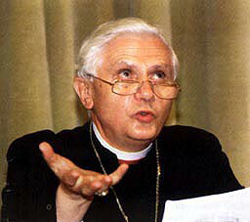
Did he protect the children as head of the CDF? |
“Aren’t you tired of feeling bad about the Church?” she asked. “It was just wonderful for a week to feel good for a change.” Then she pointed to the “indisputable triumph” of Benedict, the times he addressed the Church’s ongoing sex-abuse scandal and his emotional 20-minute encounter with five victims.
For most Catholics the Pope’s addressing the clerical sex abuse crisis defines this trip. On four occasions, including to the press corps on his trip to Washington, he expressed his pain, compassion and concern. At his meeting with the U.S. Bishops in Washington, he even admitted the sexual abuse crisis had been “badly handled at times” by the Bishops. But immediately afterward he praised the work they were doing now to restore trust.
So we have it: some words of compassion and grief for the victims and one small acknowledgment of the obvious complicity of the Bishops that could hardly be called a censure.
“But what else could he do?” my friend Jan countered. “After all, he really can’t be blamed for anything.”
Beautiful words, but no disciplinary action
On that point, I – along with many commentators on the objective facts – have to differ. What he has delivered so far are clever words, no impartial censures, no disciplinary measures to contain an ongoing crisis.
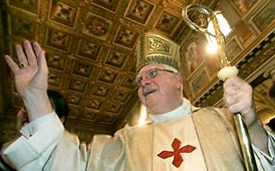
Cardinal Law at St. Mary Major Basilica |
One thing he could do is to punish complicit Bishops – so far a total of 19 American Bishops have been named either as directly involved in sexual abuse cases or in the resultant cover-up. (1) Not one has been penalized by Rome.
Even Cardinal Bernard Law wasn’t fired. He resigned of his own accord, only to go to Rome to be rewarded with very prestigious positions, among them Archpriest of St. Mary Major, the third more important basilica in Rome, after St. Peter Basilica and St John Lateran.
David Clohessy, director of the Survivors Network of Those Abused by Priests justly observes:, “Thousands of predator priests have been suspended by Bishops, but no Bishops have been suspended by the Pope. Until he does, he essentially condones risk.” (2)
Whatever happened, it happened under his watch
Benedict’s non-culpability was the second part of Jan’s reaction. Regarding this, it seems clear to me he played a large role in the earlier cover-up of the pedophile priests and Bishops. Then, in the more recent past he has often taken a clear position supporting the priests and Bishops, affirming that the public reaction against clergy sexual abuse was chiefly media-produced.
On his U.S. visit, however, he “condemned” the actions of the guilty clergy. This sudden shift of position can raise the suspicion whether he assumed this new stance from a sincere movement of heart or for some other political reason. At any rate, until he assumes a line of action consistent with those fine words, they have a hollow ring.
“If I read the stories of these victims,” Benedict told reporters on the first day of his visit, “it is difficult for me to understand how it was possible that priests betrayed in this way their mission to give healing, to give love of God to these children.” (3)
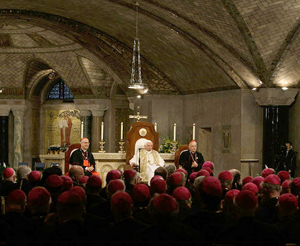
At the Immaculate Conception National Shrine: Just a quick mention of the Bishops' guilt |
There was no question of any “if” in reading the stories of victims. Joseph Ratzinger, as head of the Congregation for the Doctrine of the Faith (CDF), had certainly been reading those files for many, many years. The diocesan reports of pedophile and homosexual priests, the heart-wrenching letters of victims and families addressed to the Vatican as a last recourse effort for justice – all ended on his desk. As the one responsible for overseeing the Church’s internal judicial process resulting from accusations of sexual abuse against a minor, he had to be aware of all the case files.
For 24 years, Cardinal Ratzinger responded to the abuse accusations by referring Bishops to the rules of Crimen Sollicitationis, in force since 1962. The instruction calls for secrecy – specifically in cases where priests are accused of abusing the Sacrament of Confession to sexually proposition penitents, and in extension, to clerics accused of homosexuality, child sexual abuse and bestiality. In effect, he used that document to insure secrecy and cover up sexual abuse by priests and Bishops. There is no doubt that Ratzinger was aware of the details of those scandals for a long, long time.
Then, in 2001, a year before the crisis came to public attention in the Boston press, Card. Ratzinger and his Secretary, then Archbishop Bertone, signed a letter of instruction sent to all Bishops titled De Delictis Gravioribus. It specified that cases of sexual abuse by clerics be referred directly to the CDF and be subject “to the pontifical secret.”
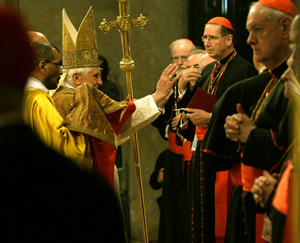
A prestigious greeting for Cardinal Mahony of Los Angeles, who recently paid $660 million to 508 victims |
Journalist Ron Fraser gives details: “In his letter of May 18, 2001, sent to the Bishops, Ratzinger pointed to the Vatican’s firm instruction, issued from Rome in 1962, that regarding any accusation brought against a priest involving solicitation, ‘those same matter should be pursued in a most secretive way … They are to be restrained by a perpetual silence. Each and everyone pertaining to the tribunal in any way … is to observe the strictest secret, which is commonly regarded as a secret of the Holy Office’ (Vatican Press, Instruction on the Manner of Proceeding in Cases of Solitication, 1962).” (4)
Card. Ratzinger also endorsed the key clause Item 13, under the Preliminaries section of the 1962 Instruction, which states: “The oath of keeping the secret must be given in these cases also by the accusers or those denouncing [the priest] and the witnesses.” (5) In effect, this enabled Bishops to use their authority to silence the victims of priestly abuse by swearing them to secrecy under pain of excommunication.
These instructions were also broadly interpreted to mean that Bishops dealing with complaints against priests could cover them up and not report them to the police.
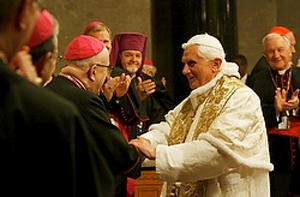
Smiles for Archbishop Pilarczyk (Cincinnati), who admitted lying and covering up clergy sexual abuse |
An editorial in the April 26, 2008 The Tablet, aptly explained the veil of secrecy placed by Ratzinger over sexual abuse cases: He chose to give “greater weight to the prevention of scandal than to the protection of vulnerable minors.”
Therefore, we face a sad contradiction in the papal visit. When speaking to the United Nations in New York, Benedict emphasized the “responsibility to protect, which is not only a right but above all a responsibility.” Nonetheless, under his direction, the CDF counseled silence and secrecy to protect the Catholic authorities rather than the most vulnerable members of the flock, the children.
Did Pope Ratzinger have a change of heart or was he just saying beautiful words to please the American audience?
Pedophile and homosexual priests are closely linked
There is a final statement worthy of attention in Benedict’s response to reporters en route to the US. He assured Catholics that he would do everything possible to see that “this” [the sexual abuse crisis] would not happen in the future by keeping pedophiles out of the seminaries: “I will not speak in this moment about homosexuality, but pedophilia, [which] is another thing. We will absolutely exclude pedophiles from the sacred ministry, this is absolutely incompatible.” (6)
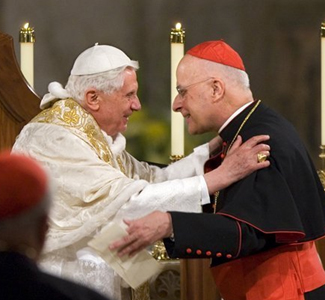
A warm embrace for Card. George, who recently covered for a pedophile priest |
He clearly states that in his opinion, homosexuality and pedophilia are two different things, not to be compared or confused. Here he supports the progressivist contention that has spread to prevent public furor against pedophilia from striking at homosexuality. Certainly there is a difference between the two crimes when studied by scholars and punished by the courts, but regarding pedophile priests in the clergy, it so happens that the two vices are intimately related. Benedict ignores this fact.
He affirms categorically there is no place for pedophiles in the Catholic priesthood, but what about homosexuals? He says nothing against the homosexual subculture that has established itself in the American Catholic Church since Vatican II.
His actions since assuming the papal office confirm his soft stance on homosexuality in the priesthood. To replace him as head of the CDF, he chose his friend Archbishop William Levada, known for complacent handling of pedophile priests when he was Bishop of Portland, and for his friendly approach to homosexuals when he became Archbishop of San Francisco. Then he appointed as Archbishop of San Francisco George Niederauer, who openly supports “tolerance’ for homosexuals and opposes a constitutional ban on same-sex “marriage.”
In 2006, Pope Ratzinger signed an unmistakably “soft” document setting out new guidelines regarding homosexuals entering the seminary. (7) Instead of condemning the sin against nature and firmly barring those who practice it or have tendencies toward it from the sacred priesthood, the document takes a more tolerant view. Only those with “deep-seated tendencies” toward homosexuality are barred from priesthood; those with “transitory problems” or “chaste” homosexuals can be accepted. New Oxford Review editor Dale Vree rightly noted that “the priesthood will continue to be or become a ‘gay’ profession, thanks to this document.” (8)
No, dear friend Jan, I do not believe that Benedict’s comforting words to the masses on the pedophilia crisis are enough for justice to be done and the Church morally healed. Nothing will change unless the Church addresses the root of the moral crisis, the toleration and favoring of both pedophilia and homosexuality in the clergy.
As Atila Guimaraes states in his work Vatican II, Homosexuality & Pedophilia, “Even if homosexual acts are not practiced, homosexuality per se is an aberration both in its tendency, the attraction of a man to another man, and in its end, the sin of sodomy. It cannot be tolerated in any degree or in any place, most especially in a place destined to form the future directors of Catholic souls and members of the Hierarchy.” [my emphasis] (9)
1. Ron Fraser, “Benedict XVI and Vatican Justice,” The Trumpet online, April 27, 2008
2. “Benedict XVI in the United States,” The Tablet, April 26, 2008
3. Benedict begins historic visit,” Washington Post online, April 16, 2008
4. “Benedict XVI and Vatican Justice,” The Trumpet online, April 27, 2008
5. Ibid.
6. John Allen, “Transcript from Papal Plane,” National Catholic Reporter online, April 15, 2008
7. “Instruction Concerning the Criteria for the Discernment of Vocations With Regard to Persons With Homosexual Tendencies in View of Their Admission to the Seminary and to Holy Orders"; for more on this document, see the article by Dale Vree, Why the Priesthood Will Continue To Become a "Gay" Profession
8. Ibid.
9. Los Angeles, Tradition in Action, 2004, p. 3

Posted on May 2, 2008

Related Articles of Interest
 Benedict XVI's Visit to a New York Synagogue Benedict XVI's Visit to a New York Synagogue
 Why the Priesthood Will Continue To Become a "Gay" Profession Why the Priesthood Will Continue To Become a "Gay" Profession
 When the Pope Becomes the Chaplain of the UN When the Pope Becomes the Chaplain of the UN
 Benedict Receiving the Koran Benedict Receiving the Koran
 The Pope Praying at the Mosque The Pope Praying at the Mosque
 Cardinal Law's Resignation Cardinal Law's Resignation
 Yes, There Is a Link between Homosexuality and Pedophilia Yes, There Is a Link between Homosexuality and Pedophilia
 |

Talks with Jan | Religious | Home | Books | CDs | Search | Contact Us | Donate

© 2002-
Tradition in Action, Inc. All Rights Reserved
|
 |
|
